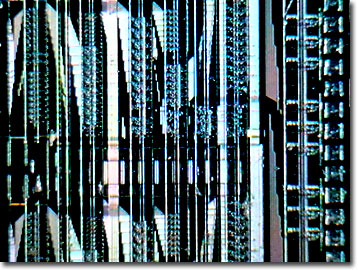Integrated Circuit Image Gallery
Intel 387 Math Coprocessor
In the late 1980s, Intel built a significant business selling math coprocessors, which provided floating-point math capabilities for the 286 and 386 microprocessors. Newer central processing units (CPUs) such as the 80486, Pentium, Xeon, and Itanium series have coprocessing capabilities built into the core processor, and as a consequence, Intel replaced their coprocessor market with the lucrative microprocessor upgrade business.

Among the major bottlenecks in scientific computer applications in the 1980s were calculations involving very large numbers or extended decimal places. The chore of converting these numbers to scientific exponential notation was so time-consuming that math coprocessors were developed for high-end customers. Microprocessor engineers transferred some of the difficult mathematical tasks and repetitive iterations away from the central processing unit and shifted them to another chip, a math coprocessor. Released in 1987, the i387 math coprocessor was designed to match the 386 microprocessor logically and physically just as the 80287 coprocessor complemented the 286 and the 8087 accompanied the 8086 and 8088 processors.
Being five times faster than the older 8087/80287 floating-point units (FPUs), the 80387 remained compatible with Institute of Electrical and Electronics Engineers (IEEE) standards. After its introduction as a support chip for the 386 microprocessor, the new floating-point unit became the foundation of all later Intel math coprocessors. It also served as the basis for the 387SX and later revisions of the 80287, the 287XL and 287XLT coprocessors. Much of the coprocessor's design was carried over into the floating-point section of the 486 microprocessor that was engineered basically as a 387 and 386 integrated onto a single silicon wafer.
Although it had the capability to run asynchronously, a 387 generally operated at the same clock speed as the 386 it was assisting. The later 387 chips tracked the newer versions of the 386 up to 33-MHz clock speeds. Other changes chip designers made in updating the floating-point capabilities of the 387 were adding sine, cosine, tangent, arctangent, and logarithmic functions. All programs written for the 80287 ran on the 387 and 387SX, but the reverse was not true.
Contributing Authors
Omar Alvarado, Thomas J. Fellers and Michael W. Davidson - National High Magnetic Field Laboratory, 1800 East Paul Dirac Dr., The Florida State University, Tallahassee, Florida, 32310.
BACK TO THE INTEGRATED CIRCUIT IMAGE GALLERY
BACK TO THE DIGITAL IMAGE GALLERIES
Questions or comments? Send us an email.
© 1995-2025 by Michael W. Davidson and The Florida State University. All Rights Reserved. No images, graphics, software, scripts, or applets may be reproduced or used in any manner without permission from the copyright holders. Use of this website means you agree to all of the Legal Terms and Conditions set forth by the owners.
This website is maintained by our
Graphics & Web Programming Team
in collaboration with Optical Microscopy at the
National High Magnetic Field Laboratory.
Last Modification Friday, Nov 13, 2015 at 01:19 PM
Access Count Since September 17, 2002: 13706
Visit the website of our partner in introductory microscopy education:
|
|
